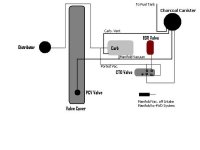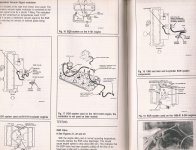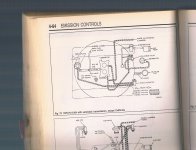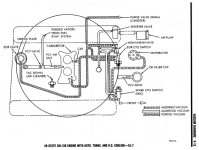I sure appreciate the assistance and advise of fellow members 69jeepcj and policemonkey161 as they are experienced jeep owners whom currently drive the same or similar vehicles . My reference manuals are coming up short on proper vacuum diagrams for this jeep and my order of a 1980 AMC shop manual will not reach us soon enough to help. Yes , it would be good to see the intake and know what emmissions equipment that will be used for emmissions compliance .
I could help with what knowledge I have of these emmissions systems , but if its better to go with the book for accuracy for this vehicle to be period correct for compliance purposes , then I guess the posted diagram and both 69jeepcj and policemonkey161 can reference best from their jeeps and most likely have best reference to them than I currently have. I know when I did my vacuum lines on my previously owned '78 cherokee 360 , I just swapped it line by line. Sorry that wont help now. If its being questioned about the large nipple on the air horn , that is to feed vapor to the float bowl from the canister to burn in engine off -idle when vacuum motor on canister receives vacuum signal off-idle and the vacuum is routed through a thermal vacuum switch , actually called CTO for this jeeps purposes . I believe the distributor shares the same vacuum signal from the carburators float bowl , not throttle body for off-idle response but the distributor will not go to CTO as it does not need to be temperature controlled until engine is warm unlike EGR and CHARCOAL CANISTER do. I think that should be key , what is needed to work after engine is warm and what can work before so. Distributor signal , no CTO but off idle signal , EGR and CANISTER , CTO from off-idle signal port. Throttle body(lower carb) signal present at idle only , lost after acceleration . Float bowl(upper carb) signal gained after acceptation . Will need vacuum advance above idle and EGR and CANISTER enrichment only after acceleration . The EGR signal is metered by CTO and the CANISTER signal metered by CTO and vacuum motor. Naturally it is important that all be routed correctly and hoping 69jeepcj and policemonkey161 ' s jeeps and personal reference can properly sort as it is taking long to get my shop manual from Willys overland . With regards to the thermal vacuum switches , if one were placed in thermostat housing , that would only supply vacuum with warm engine , and if the other in intake , that would supply constant but stronger above idle signal for CTO , but still we need the correct routing for correct operation ? That's really all I know and is basic , I know you guys have the best reference available , your jeeps ! Wish I could be of more real world help to positively identify , but the jeeps and their owners know better than me ! LOL ! Best of luck and hope my post is more helpful to you all and less confusing as well . Hope my post digest well and does not give indigestion ! Double LOL !









